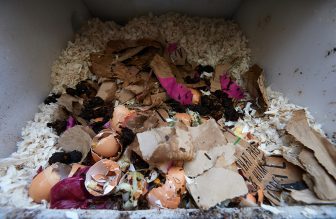
Composting fabric scraps can prevent textile waste from going to landfills. Image: Fashion Institute of Technology.
By Borjana Alia
I’ve always loved fashion.
From mixing and matching outfits for my Bratz dolls and creating little piles of clothing across my room to eventually learning how to sew my own garments, I’ve always loved fashion.
As I got older, social media came into play, not only in my life but also in the fashion industry – something that connects everyone to what’s going on in the industry, making it so accessible to see what’s being shown on the runway everywhere.
Along with being able to see what’s on the runway, social media also makes it easier to learn more about the garments themselves. Finding out what fabric something is made of, the process behind it and everything in between only made me love fashion more.
With all of this knowledge, I started to form questions about why this information on fabrics, sourcing and the process is important. Why do some brands and designers strive to share this information, while others don’t?
It all comes down to how eco-friendly or eco-conscious brands try to be. When creating fashion, from shirts all the way down to shoes – there are a plethora of options in fabrics and materials to choose from.
Of course, some are going to be pricier or even harder to source, but in the end it may be worth it. It is all up to the brands, what they stand for and their budget.
If a brand wants to provide fashionable items that are sourced using sustainable materials such as cotton, it will not only cost more money but also time. That’s why fast fashion has taken such a strong lead in the fashion industry.
Being able to stay on top of fast-moving trend cycles and create clothing quickly allows fast fashion companies to keep customers coming back.
On the other hand, designers who strive to upcycle and are aware of the ecological footprint their clothing puts on Earth have a much longer turnaround time. Many more factors are at play for designers who want to focus on what goes into their garments.
I never really considered the importance of choosing fabrics and sourcing. Not to be shallow, but I only ever cared for whether I thought a garment was cute and wearable. It wasn’t until I started seeing some of my favorite brands share their processes that I understood the environmental impact behind garment making.
Now, with my knowledge of fabrics and their environmental impacts, I can’t help but admire brands that take the extra step in the production process and are aware of what is going into their garments.
Even on a personal level, the rare times when I feel spontaneous and want to create my own garments – usually a basic pair of trousers or a skirt – I make sure to go the extra mile with my fabrics.
Looking through my giant box of old scraps that I’m convinced will come in handy one day to going to the thrift store and finding pieces that I could cut up and work with – these are some of the ways I try to be more sustainable when creating clothing.
But I always find it important to note that it isn’t up to us, regular old Joes to feel guilty for supporting fast fashion, or not having the means to be sustainable in fashion.
Larger designers and brands have the capacity to accept accountability and realize their wrongdoings towards the environment.
For those who don’t, I take note of that, and so does the Earth.